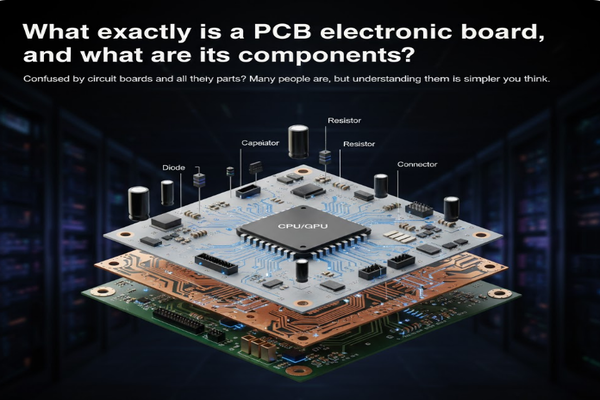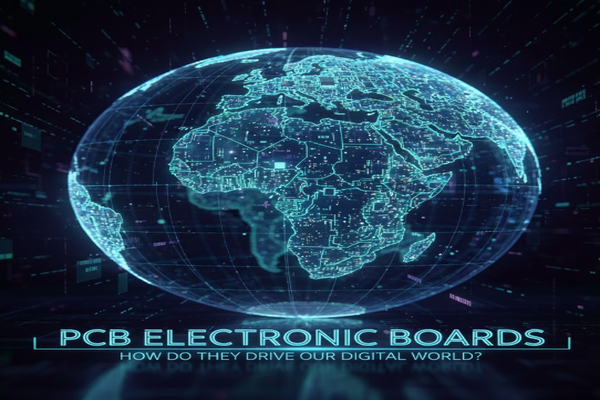Ever wondered what truly powers your favorite gadgets? Without a key component, our digital lives would grind to a halt.
PCB electronic boards1 are the unseen heroes. They connect and power nearly every electronic device, from your smartphone to medical equipment, acting as the central nervous system for all components to communicate.
I used to think of electronics as magic, but then I learned about the silent workhorse behind it all: the Printed Circuit Board. Let's pull back the curtain and see how these unsung heroes make our tech tick, and what makes some stand out from the rest.
What exactly is a PCB electronic board, and what are its components?
Confused by circuit boards and all their tiny parts? Many people are, but understanding them is simpler than you think.
A PCB (Printed Circuit Board) is a flat board that mechanically supports and electrically connects electronic components using conductive pathways2, etched from copper sheets3 laminated onto a non-conductive substrate4. It's the foundation for almost all modern electronics.

A PCB acts like a miniature city for electronic components. It starts with a base material, often fiberglass, which is insulating. Copper layers are then laminated onto this, forming the "streets" or traces that carry electrical signals. Holes, called vias, connect these layers. Components like microchips5, resistors6, and capacitors7 are then soldered onto specific pads. I've seen firsthand how precise this manufacturing needs to be, as even a tiny error can disrupt an entire system. Think of a complex city map; each street, each intersection, must be perfect for traffic to flow. This intricate design allows power and data to flow efficiently, bringing devices to life.
Key PCB Components
| Component Type | Function | Example |
|---|---|---|
| Substrate | Provides mechanical strength and electrical insulation | FR-4 (fiberglass reinforced epoxy laminate) |
| Copper Traces | Conducts electricity between components | Thin etched lines on the board |
| Solder Mask | Protects copper traces and prevents short circuits | Green or blue coating on the PCB surface |
| Silkscreen | Labels components for assembly and troubleshooting | White text and symbols on the solder mask |
| Vias | Connects different layers of the PCB | Small drilled holes |
Faced with such a diverse range of PCB electronic boards, how do I differentiate and apply them?
Overwhelmed by the sheer variety of circuit boards out there? Knowing which one fits your project can feel like a puzzle.
Differentiating PCBs involves understanding their layer count, material, and specific application. Single-sided PCBs are simple, while multi-layer boards handle complex circuits. Materials range from basic FR-4 to specialized options for high-frequency needs.

The PCB landscape is vast, and choosing the right board is crucial for any electronic project. I've learned through trial and error that what works for a simple LED circuit won't cut it for a high-speed data processor. The number of layers is a primary differentiator; single-sided PCBs8 are the most basic, often used in simple calculators, as they have components on one side and traces on the other. Double-sided PCBs allow for more complex routing, while multi-layer PCBs9 (with 4, 6, 8, or even more layers) are essential for advanced electronics like computers and sophisticated communication devices, enabling very dense and intricate circuits. Beyond layers, the material matters. Standard FR-410 is common, but for high-frequency signals or harsh environments, specialized materials like Rogers11 or Polyimide12 are necessary due to their superior thermal and electrical properties. Consider the environment and performance requirements of your device to guide your choice.
PCB Types by Layer Count and Application
| Type | Description | Common Applications |
|---|---|---|
| Single-sided | One layer of conductive material; simple and cost-effective | Calculators, LED lighting, simple toys |
| Double-sided | Two layers of conductive material, with vias connecting them | Power supplies, amplifiers, automotive dashboards |
| Multi-layer | More than two layers of conductive material; complex routing | Smartphones, computers, servers, medical equipment |
| Flexible PCB | Built on flexible plastic substrate; can bend and conform to shapes | Wearable devices, cameras, aerospace systems |
| Rigid-Flex PCB | Combines rigid and flexible board technologies | Medical implants, industrial controls, high-end cameras |
What unique advantages will you gain by choosing South-Electronic PCB solutions?
Looking for a competitive edge in your electronic designs? Not all PCB manufacturers offer the same level of quality and innovation.
South-Electronic provides advantages like cutting-edge materials, advanced manufacturing processes, and rigorous quality control. This ensures reliable, high-performance PCBs tailored to specific industry needs, from consumer electronics to aerospace.

When I'm sourcing PCBs, I prioritize reliability and performance, and that's where a supplier like South-Electronic stands out. They don't just manufacture boards; they partner with you to ensure your vision becomes a functional reality. Their commitment to advanced materials means they can handle everything from standard consumer electronics to high-frequency communication systems and extreme-environment aerospace applications. I've personally seen the difference high-quality substrate and precise etching make in preventing signal degradation and ensuring longevity. Furthermore, their manufacturing processes incorporate strict quality checks at every stage. This minimizes defects and ensures consistent performance, which is critical for complex, mission-critical devices. They understand that a PCB is more than just a piece of hardware; it's the heart of your product, and its failure can be catastrophic. Their solutions offer the peace of mind that comes with knowing your electronics are built on a solid, reliable foundation, pushing the boundaries of what's possible in the digital world.
South-Electronic PCB Advantages
| Feature | Benefit | Impact on Your Project |
|---|---|---|
| Advanced Material Selection | Access to specialized substrates (e.g., Rogers11, Polyimide12) for diverse needs | Enhanced performance for high-frequency, high-temperature, or flexible applications |
| Precision Manufacturing | Tight tolerances, fine line etching, and high-density interconnect (HDI) capability | Allows for smaller, more powerful, and complex designs |
| Rigorous Quality Control | Multi-stage inspection, electrical testing, and adherence to industry standards | Ensures high reliability, reduces failure rates, and extends product lifespan |
| Custom Design Support | Engineering assistance and rapid prototyping for unique specifications | Faster development cycles and optimized designs for specific requirements |
Conclusion
PCBs are the invisible force powering our digital age. Understanding their types and choosing reliable manufacturers like South-Electronic ensures robust, cutting-edge electronics.
Explore this link to understand the fundamental role of PCB electronic boards in modern electronics. ↩
Discover how conductive pathways are essential for electrical connections in PCBs. ↩
Find out why copper sheets are crucial for creating effective PCBs. ↩
Understand the role of non-conductive substrates in supporting electronic components. ↩
Explore the significance of microchips in the operation of PCBs. ↩
Learn about the function of resistors in controlling electrical flow on PCBs. ↩
Discover how capacitors store and release electrical energy in PCBs. ↩
Find out the uses and benefits of single-sided PCBs in electronics. ↩
Learn about the complexity and advantages of multi-layer PCBs. ↩
Explore the properties of FR-4 and its common applications in PCB manufacturing. ↩
Understand the benefits of Rogers material for high-frequency applications. ↩
Discover how Polyimide enhances performance in extreme environments. ↩



